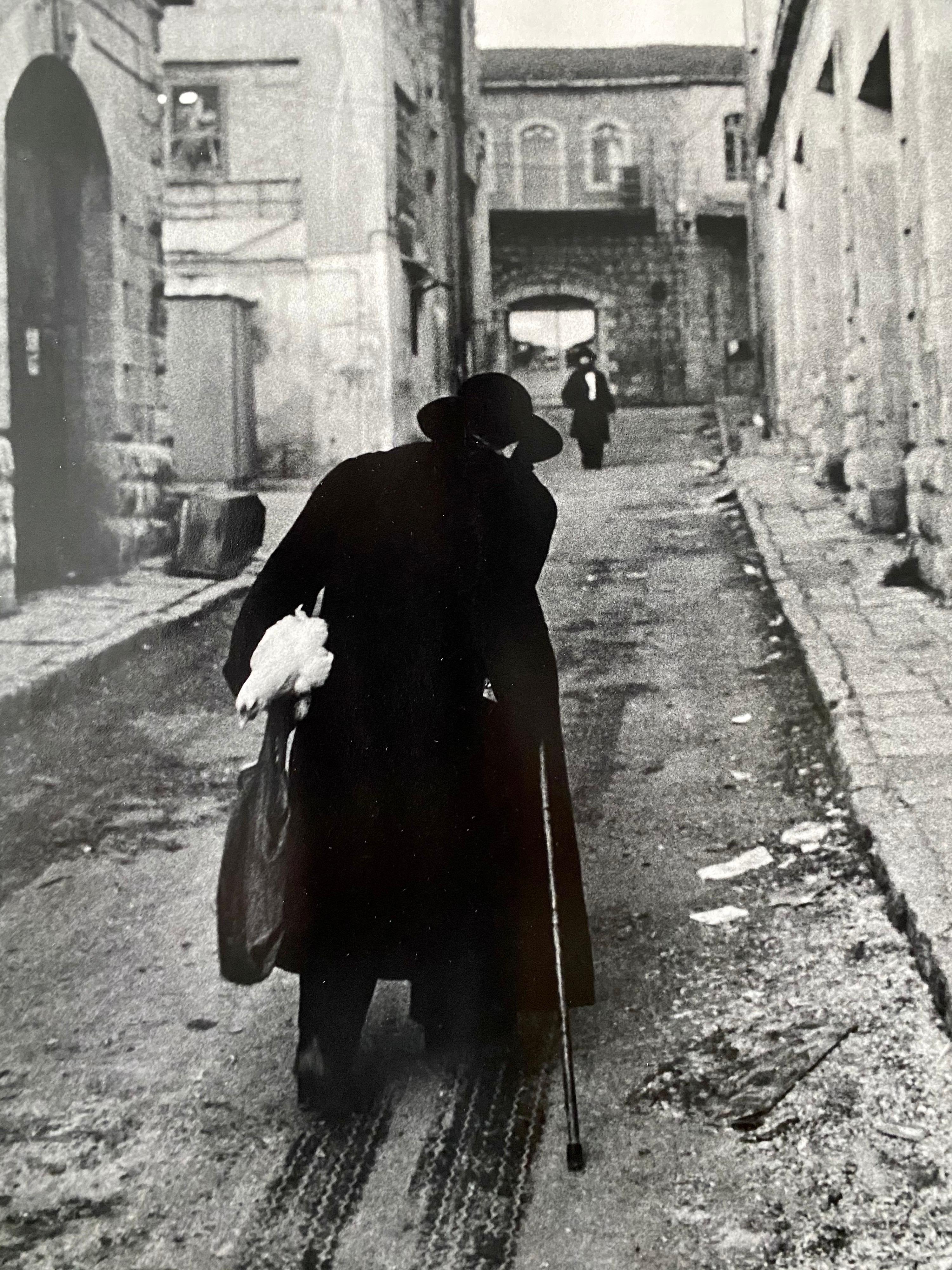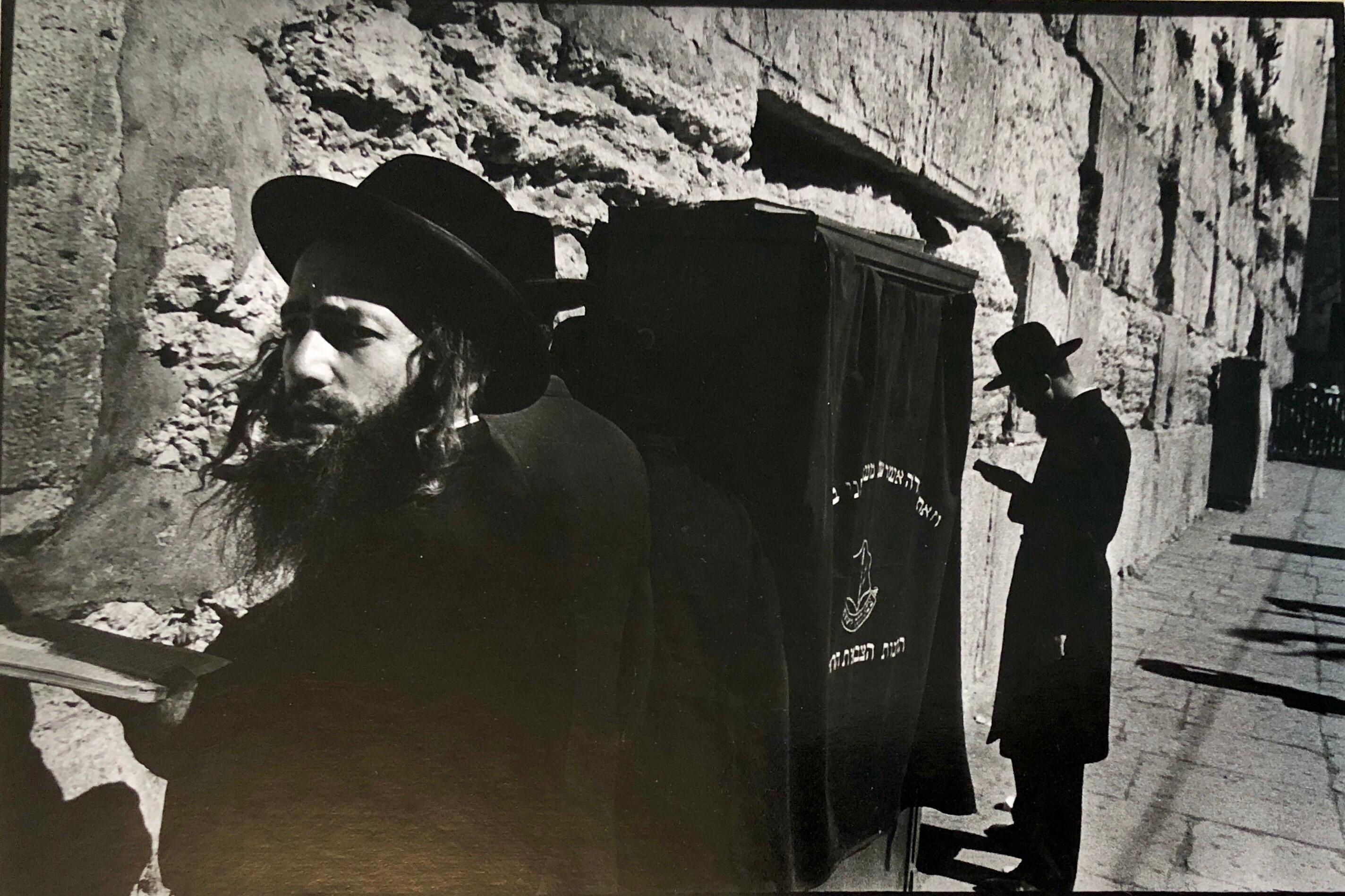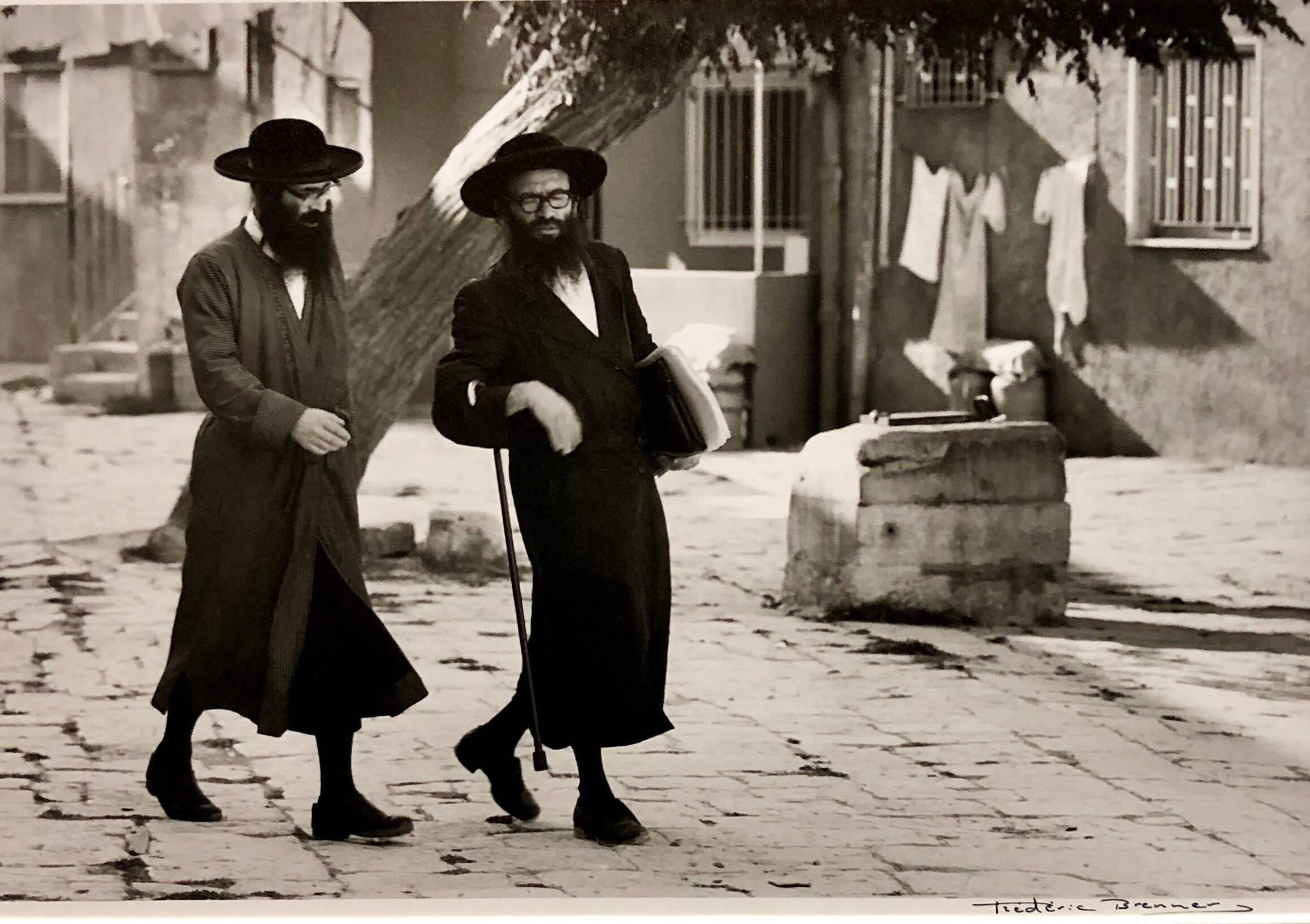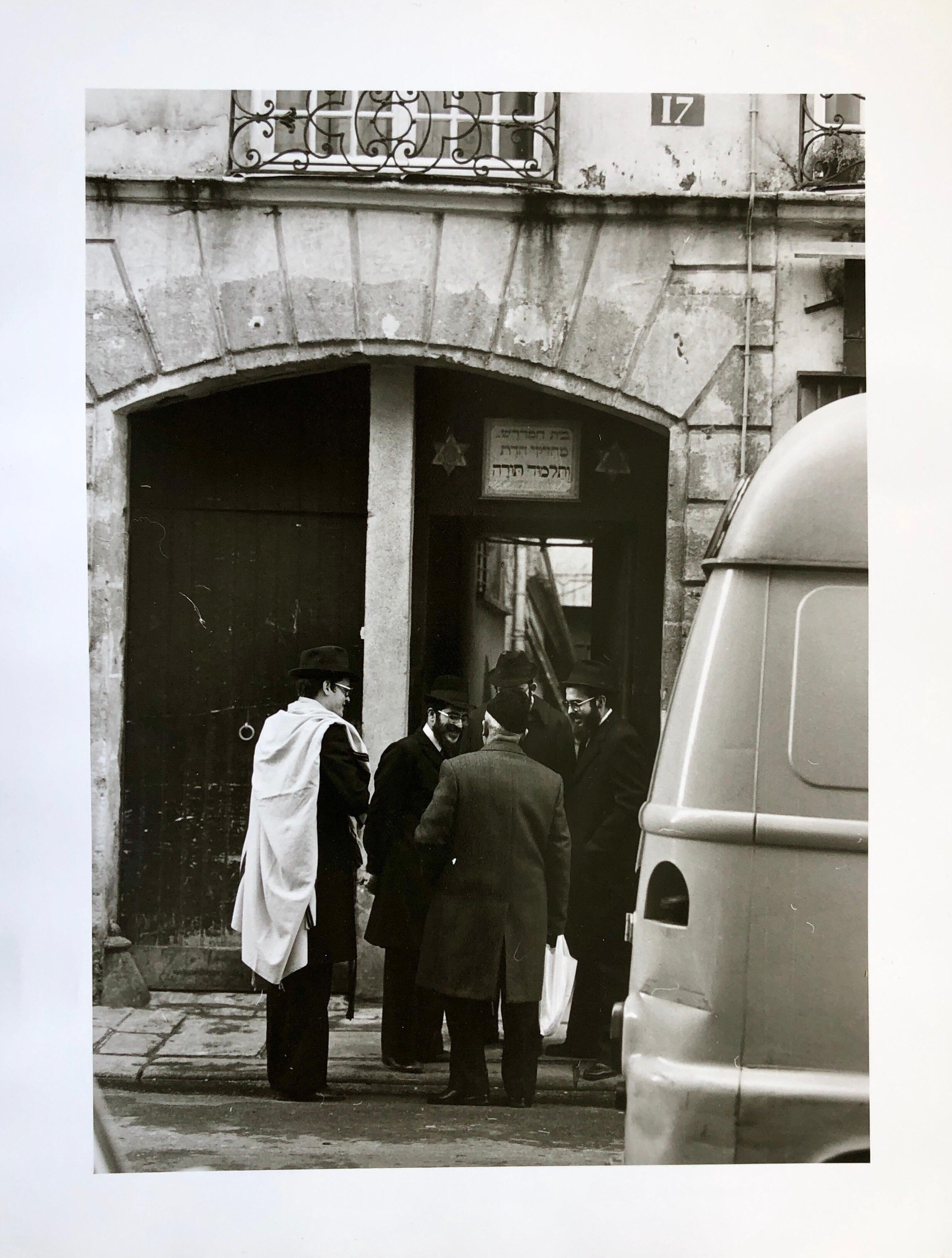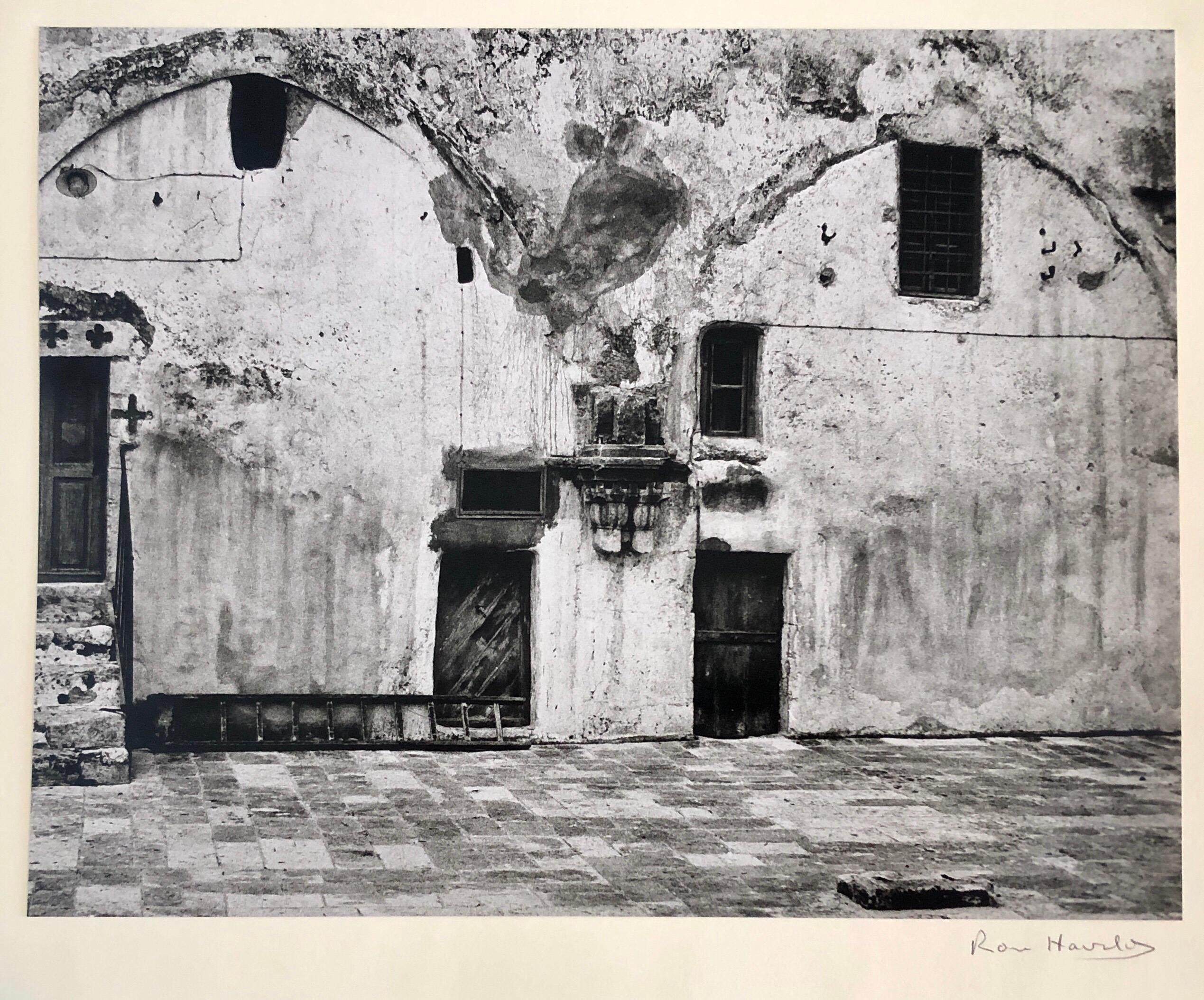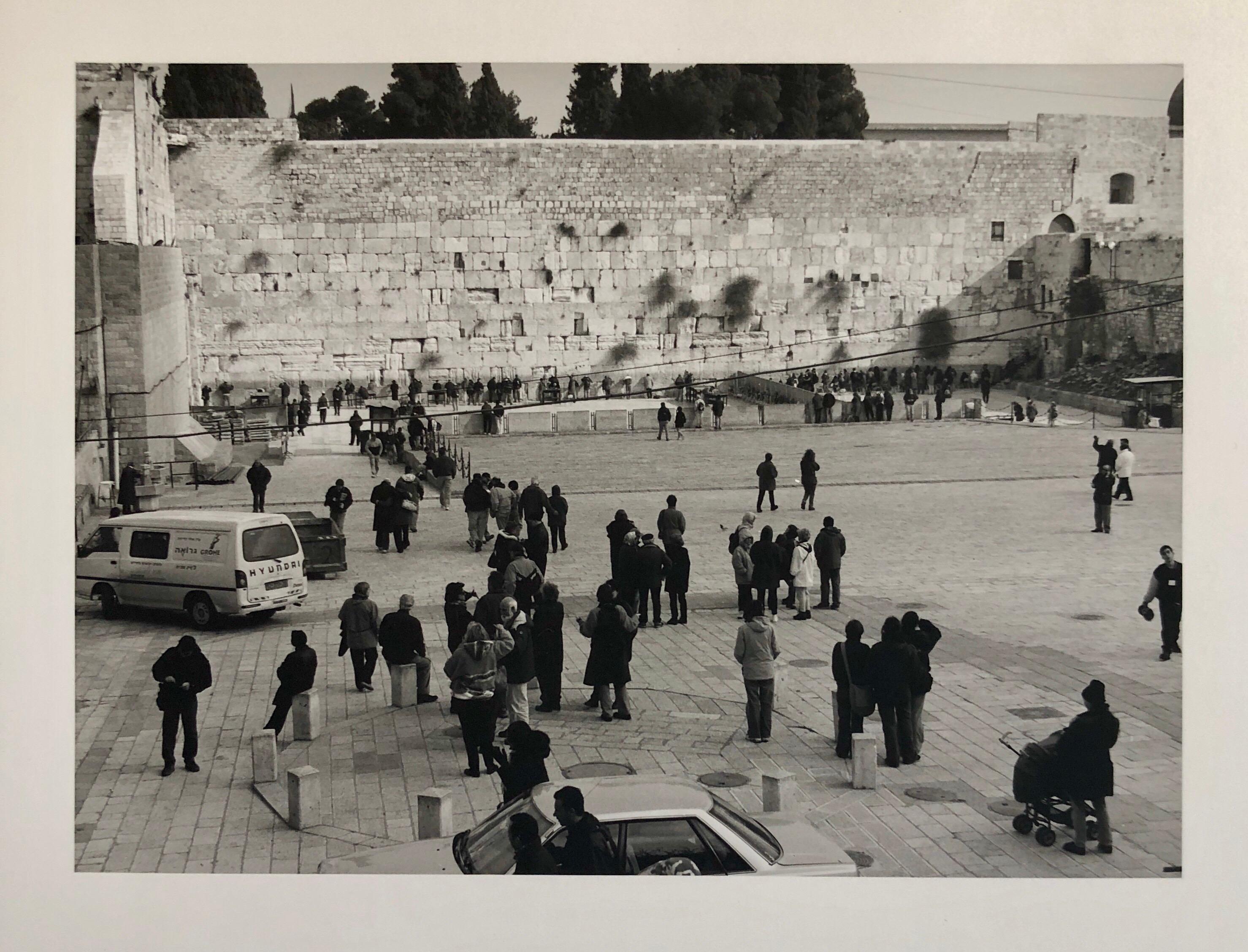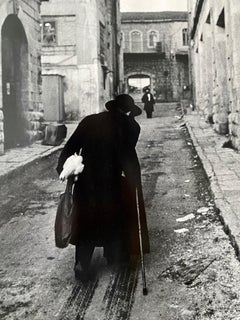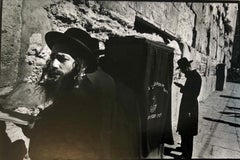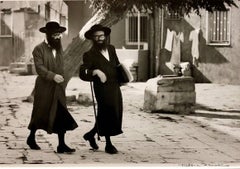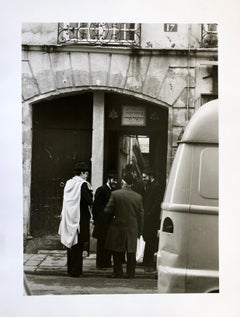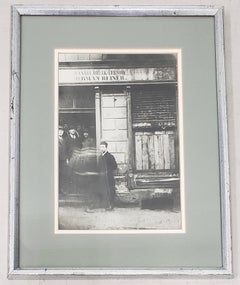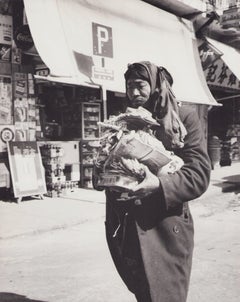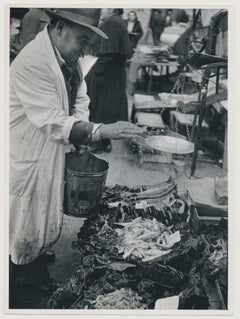Items Similar to Vintage Silver Gelatin Signed Print Old Jew in Jerusalem Pious Craftsman
Want more images or videos?
Request additional images or videos from the seller
1 of 8
UnknownVintage Silver Gelatin Signed Print Old Jew in Jerusalem Pious Craftsman1967
1967
$1,400
£1,070.37
€1,232.86
CA$1,961.83
A$2,190.20
CHF 1,147.63
MX$26,810.17
NOK 14,574.92
SEK 13,742.30
DKK 9,200.93
About the Item
Rare vintage signed and dated silver gelatin black & white framed photograph.
This photo is signed but I cannot make out the signature. It is from the aftermath of the six day war. Leonard Freed, Micha Bar Am, Henri Cartier-Bresson, David Rubinger and other important Magnum Photos photographers where there snapping photos. not sure who this is by but it is a beautiful piece
- Creation Year:1967
- Dimensions:Height: 24.5 in (62.23 cm)Width: 21 in (53.34 cm)
- Medium:
- Movement & Style:
- Period:
- Condition:size includes frame.
- Gallery Location:Surfside, FL
- Reference Number:1stDibs: LU38213119202
About the Seller
4.9
Platinum Seller
Premium sellers with a 4.7+ rating and 24-hour response times
Established in 1995
1stDibs seller since 2014
1,786 sales on 1stDibs
Typical response time: <1 hour
- ShippingRetrieving quote...Shipping from: Surfside, FL
- Return Policy
Authenticity Guarantee
In the unlikely event there’s an issue with an item’s authenticity, contact us within 1 year for a full refund. DetailsMoney-Back Guarantee
If your item is not as described, is damaged in transit, or does not arrive, contact us within 7 days for a full refund. Details24-Hour Cancellation
You have a 24-hour grace period in which to reconsider your purchase, with no questions asked.Vetted Professional Sellers
Our world-class sellers must adhere to strict standards for service and quality, maintaining the integrity of our listings.Price-Match Guarantee
If you find that a seller listed the same item for a lower price elsewhere, we’ll match it.Trusted Global Delivery
Our best-in-class carrier network provides specialized shipping options worldwide, including custom delivery.More From This Seller
View AllVintage Silver Gelatin Print Rabbi, Jerusalem Alley Israeli Judaica Micha Bar-Am
By Micha Bar-Am
Located in Surfside, FL
Rare vintage signed and dated silver gelatin black & white unframed photograph. (printed circa 19730-1981) signed and numbered in ink on recto. Hand developed by or under the personal direction of Micha Bar Am at the studio of acclaimed printer Thomas Consilvio in Beverly Hills, California. In 1981, the negatives were retired and donated by Bar-Am to the permanent archives of the Tel-Aviv Museum, Israel. This one has the feel of a Roman Vishniac photo.
Micha Bar-Am (Hebrew: מיכה בר-עם) (born 1930 in Berlin, Germany) is an Israeli journalistic photographer. His images cover every aspect of life in Israel in the past sixty years.
Since 1968 he has been a correspondent with Magnum, the photographic cooperative. From 1968 to 1992, he was the New York Times photographic correspondent from Israel. He has published several books of photography, beginning in 1957. His work is held in numerous international museums and institutes throughout the world.
Born in Berlin to a Jewish family, Bar-Am moved with his parents in 1936 to then British Mandate of Palestine. He attended local schools. He was drafted in 1948 and served during Israel's War of Independence, when he was part of the Palmach Unit. Afterward, he worked several jobs, including as a locksmith and a mounted guard, before becoming a photographer. In 1949 he co-founded the kibbutz Malkia in Galilee. Later he became a member of Kibbutz Gesher HaZiv.
Photography career
In the early 1940s, Bar-Am started taking pictures of life on a kibbutz; he used borrowed cameras until he bought a Leica. After his military service, he began photographing more seriously.
After publishing his first book, Across Sinai (1957), Bar-Am gained work as a photographic reporter and in the editorial staff of the Israeli Army magazine, Ba-Mahaneh, from 1957 to 1967. In 1961 he covered the Adolf Eichmann trial. In 1967 he covered the Six-Day War, during which time he met Cornell Capa. Many of his war images brought him renown. Since 1968, he has been a correspondent for Magnum Photos. In 1974 he helped Capa found the International Center of Photography in New York City.
In 1968, Bar-Am also became the photographic correspondent from Israel for the New York Times, a position he held until 1992. From 1977-92, he was head of the department of photography at the Tel Aviv Museum of Art.
He says that he has adopted Robert Capa saying, "If your photographs aren't good enough, you weren't close enough,"
Awards
2000--Israel Prize for photography.
1993—Enrique Kavlin Prize, Israel Museum, Jerusalem, Israel
1985-86--Nieman Fellow, Harvard University, Cambridge, Massachusetts, USA
1985—IBM Fellowship, Aspen, Colorado, USA
1985—Golden Flamingo Award for Photographic Poster, Arles, France
1985--Fulbright Grant
Books
Southward: Micha Bar-Am, Photographs, Israel: The Negev Museum of Art, 2013
Insight: Micha Bar-Am's Israel, London: Koenig Books / Israel: Open Museums, 2011
Israel: A Photobiography, USA: Simon & Schuster, 1998
The Last War, Israel: Keter Publishers, 1996
Painting With Light: The Photographic Aspect in the Work of E.M. Lilian, Israel: Tel Aviv Museum of Art/Dvir Publishing, 1991
Jewish Sites in Lebanon, USA: Moreshet Eretz-Yisrael/Ariel, 1984
The Jordan, Israel: Masada Ltd., 1981
Portrait of Israel, USA: New York Times/American Heritage Press, 1970
Across Sinai, Israel: Hakibbutz Hameuchad, 1957
Collections
Israel Museum, Jerusalem, Israel
Tel Aviv Museum of Art, Tel Aviv, Israel
Haifa Museum, Haifa, Israel
The Museum of the Jewish People at Beit Hatfutsot, Tel Aviv, Israel
The Museum of Photography at Tel Hai, Tel Hai Kibbutz, Israel
International Center of Photography, New York, USA
The Museum of Modern Art, New York, USA
Museum of Fine Arts, Houston, USA
International Museum of Photography at George Eastman House, Rochester, USA
Skirball Museum, Los Angeles, USA
Minneapolis Institute of Arts, Minneapolis, USA
Henry Buhl Collection, New York, USA
Ludwig Museum, Cologne, Germany
Folkwang Museum, Essen, Germany
Bibliothèque Nationale, Paris, France
Musée d'Art et d'Histoire du Judaïsme, Paris, France
Collection FNAC, Paris, France
Fundacion “La Caixa”, Barcelona, Spain
National Maritime Museum, London, UK
Magnum Photos: Photographic Collection, Harry Ransom Center, University of Texas at Austin, USA
This photo is signed. It is from the height of the war. Leonard Freed, Micha Bar Am, Henri Cartier-Bresson, David Rubinger...
Category
1970s Realist Black and White Photography
Materials
Silver Gelatin
Jerusalem 1967 Vintage Silver Gelatin Photograph Western Wall Kotel Hamaaravi
By Richard Gordon
Located in Surfside, FL
Richard Gordon was born in Chicago in 1945. He studied Political Science at the University of Chicago and did not begin photographing until he worked at a photography studio in 1965. Early in Gordon’s career, Robert Frank critiqued his work and stated that he “loved photography too much.” Gordon frequently makes photographic references in his work and pays homage to the photographers who influenced him: Eugène Atget, Walker Evans, Robert Frank and Helen Levitt. Bookmaking has been an important element of Gordon’s photography from the beginning; he created his own press, Chimaera Press, and published Meta Photographs (Chimaera Press, 1978), One More for the Road: The Autobiography of a Friendship 1966-1996 (Flâneur Bookworks, 1996), American Surveillance: Someone to Watch Over Me (Chimaera Press, 2009), and Notes from the Field (Chimaera Press, 2012), as well as handmade and limited edition books.
Richard Gordon’s photographs are represented in many institutional collections including: Art Institute of Chicago; Bibliothéque National, Paris; Centre Nationale de la Photographie, Paris; Corcoran Gallery of Art; J. P. Getty Museum (Wagstaff Collection); Library of Congress; Museum Ludwig, Cologne, Germany; Museum of Fine Arts, Houston; New York Public Library; Oakland Museum of Art; San Francisco Museum of Art; Santa Barbara Museum of Art; Stanford Museum of Art; and University of Colorado, Boulder.
From the David C. and Sarajean Ruttenberg Collection
The Ruttenbergs are longtime art lovers who have collected abstract expressionist paintings, African art, sculpture, graphics, old watches and photographs-lots and lots of photographs.
They started collecting them in the 1960s when the medium was still the stepchild of the arts. They kept collecting until they had more than 3,000 prints, 99 of which are in the Art Institute exhibit, ``The Intuitive Eye:
Photographs from the Collection of David C. and Sarajean Ruttenberg.``
The show encompasses the entire history of photography with black-and-white and color prints from every genre, It includes street photography by Walker Evans and Garry Winogrand, glamour shots by Edward Steichen and Richard Avedon, nudes by Robert Mapplethorpe and Nicholas Muray...
Category
1960s American Realist Black and White Photography
Materials
Black and White, Silver Gelatin
Dans le Quartier Hongrois de Mea Shearim, Jerusalem Vintage Silver Gelatin Print
By Frederic Brenner
Located in Surfside, FL
Meah Shearim photograph of Torah scholars. Rabbis in Jerusalem. Photo of Hungarian quarter.
Frédéric Brenner (born 1959) is a French photographer known for his documentation of Jewish communities around the world. His work has been exhibited internationally, among others, at the International Center of Photography in New York, the Musée de l'Élysée in Lausanne, Rencontres d'Arles in Arles, the Brooklyn Museum in New York, and the Joods Historisch Museum in Amsterdam.
Brenner was born in Paris and grew up in France. In 1981, Brenner received a B.A. in French Literature and Social Anthropology from the Paris-Sorbonne University. He went on to study at the École des hautes études en sciences sociales and received a M.A. in Social Anthropology, also awarded by the Sorbonne.
Brenner is the recipient of the Niépce Prize and his book Diaspora: Homelands in Exile won the 2004 Visual Arts Award from the Jewish Book Council.
At age 19, Brenner began photographing Orthodox Jews in the Mea Shearim neighborhood of Jerusalem. Initially, he believed this was "authentic Judaism," but his approach quickly evolved into an exploration of the multiplicities of dissonant identities.
In 1981, Brenner began photographing Jewish communities around the world, exploring what it means to live and survive with a portable identity and how Jews adopted the traditions and manners of their home countries and yet remained part of the Jewish people. He spent 25 years chronicling the diaspora of the Jews across the world from Rome to New York, India to Yemen, Morocco to Ethiopia, Sarajevo to Samarkand. Brenner has published five books and directed three films. His work has been shown in museums and galleries around the world. He has been represented by Howard Greenberg Gallery in New York since 1990.
Brenner’s opus Diaspora: Homelands in Exile was published as a two-volume set of photographs and texts by HarperCollins in 2003 and appeared in four foreign editions. Diaspora was also a major exhibition, which opened in New York at the Brooklyn Museum in 2003 and traveled to nine other cities in America, Europe and Mexico. In reviewing the book, The New Yorker wrote: “Brenner's work—elegiac, celebratory, irreverent—transcends portraiture, representing instead a prolonged, open-ended inquiry into the nature of identity and heritage.” NPR's Robert Siegel has described Brenner's work as "a celebration of the diversity and complexity of diaspora."
In 2006, Brenner founded This Place, a collective photography project aimed at recontextualizing Israel from multiple perspectives. The photographers working on this project include Wendy Ewald, Martin Kollar, Josef Koudelka, Jungjin Lee...
Category
1970s Realist Black and White Photography
Materials
Silver Gelatin
Vintage Signed Silver Gelatin Photograph Chabad Shul Pletzl Paris Judaica Photo
Located in Surfside, FL
17 Rue des Rosiers Paris, France.
A small Shul in the old Jewish quarter of Paris (the Pletzel), known as the ‘Zibetzin’, located at 17 Rue De Rosiers, The Lubavitcher Rebbe was kno...
Category
1970s Modern Black and White Photography
Materials
Silver Gelatin
Vintage Silver Gelatin Photograph Wallscape, Jerusalem Architectural Photo
Located in Surfside, FL
Jerusalem Architecture Photo
This is for one Photograph from the portfolio entitled "Jerusalem: City of Mankind," The mounting is 14 X 17 inches. ...
Category
1970s Modern Landscape Photography
Materials
Photographic Paper, Silver Gelatin
Jerusalem, Israel Western Wall Ed of 5 Vintage Silver gelatin Photograph Print
By Mikael Levin
Located in Surfside, FL
Photo Image taken in black & white of Western Wall (Wailing Wall) Kotel Hamaaravi in Jerusalem Israel. Hand signed, dated and titled. From very small edition of just 5 prints.
(American-Israeli) Born in New York City, Mikael Levin grew up in Israel, the United States and France. He attended Williams College and received a B.A. in Film and Photography from Hampshire College in 1976 before studying at the Academy of Fine Arts in Stockholm. Levin's first published project was Silent Passage (1985), a series of romantic, reflective landscape photographs inspired by a pond in Sweden. This was followed by several other series, including Les Quatre Saisons du Territoire, a study of the changes in land use in western France; Borders, which focused on the political, practical, and conceptual transformation of national borders in contemporary Europe; and War Story, Levin's reconstruction of the journey his father, the war correspondent Meyer Levin, made while traveling with the photographer Eric Schwab during World War II. Meyer Levin wrote of these experiences in In Search (1950), which described his view of the final battles of World War II and the liberation of the Nazi concentration camps in 1944-45. Levin photographed sites his father and Schwab had visited as they appear today. These photographs and passages from the elder Levin's writings formed an installation work at ICP in 1997, and were also published as a book. Levin's most recent project, Common Places: Cultural Identity in the Urban Environment, considers the relationship between the past and present in the urban environments of four European cities: Katrineholm, Cambrai, Erfurt, and Thessaloniki.
Although inflected differently in each series, Mikael Levin's photographs have in common their interest in the emotional, intellectual, and historical significance of landscape. His work ignites landscape's capacity simultaneously to recall and overwrite the events of the past, especially in works such as War Story and Common Places. His photographs represent a new approach to landscape photography that reinvigorates this traditional genre.
Lisa Hostetler
Handy et al. Reflections in a Glass Eye: Works from the International Center of Photography Collection, New York: Bulfinch Press in association with the International Center of Photography, 1999
Mikael Levin has been exhibited widely in the US and in Europe, including solo exhibitions at the Jewish Museum, Paris, 2010, the Berardo Museum, Lisbon, 2009, the Bibliotheque Nationale, Paris, 2003, the International Center of Photography, New York, 1997, and Fundación Mendoza, Caracas, 1980. His work was included in the Venice Biannual in 2003. Judaic, Judaica.
SELECT GROUP EXHIBITS
2018 Marquee Projects...
Category
Early 2000s Post-Modern Black and White Photography
Materials
Silver Gelatin
You May Also Like
Rare Silver Gelatin Photograph "Jewish Deli, Poland" c.1930
Located in San Francisco, CA
Silver Gelatin Photograph "Jewish Deli, Poland" c.1930
Rare photograph of a group of men standing in the doorway of a Jewish Deli in Poland in the 1930s....
Category
Early 20th Century Photorealist Black and White Photography
Materials
Photographic Film
Hong Kong, Man, Collector, Black and White Photography, 1960s, 30 x 23, 8 cm
Located in Cologne, DE
Hanna Seidel (1925 to 2005) lived and worked in Argentina for many years. She was a world traveller, journeying to South America in the 1950s and to Central America, Japan, India, an...
Category
1960s Modern Portrait Photography
Materials
Black and White, Silver Gelatin
Seller, Market, Street Photography, Black and White, Italy 1950s, 17, 7 x 13 cm
By Erich Andres
Located in Cologne, DE
Silver Gelatine Print by Erich Andres, ca 1950.
Andres was born 1905 in Germany and passed away 1992. He started his career as a photographer in 1920. He was one of the first photogr...
Category
1950s Modern Black and White Photography
Materials
Silver Gelatin, Black and White
Father Neophitus
By Micha Bar-Am
Located in Mount Pleasant, SC
Father Neophitus, Santa Katarina Monastery, Sinai, 1967. It was 3 or 4 a.m. The Greek Orthodox priest had just finished baking bread and was back in his cell for a glass of ouzo and a hand-rolled cigarette. In the morning the bread would be given to Bedouin in the area in accordance with an agreement made centuries ago, which guaranteed the safety of the small group of monks among tribes that were initially hostile.
-16x20 inch photograph signed and numbered by photographer. 215/300
©Micha Bar Am
Category
19th Century Contemporary Black and White Photography
Materials
Silver Gelatin
Ecuador, Man, Handcraft, Black and White Photography, 1960s, 29, 1 x 23, 1 cm
Located in Cologne, DE
Hanna Seidel (1925 to 2005) lived and worked in Argentina for many years. She was a world traveller, journeying to South America in the 1950s and to Central America, Japan, India, an...
Category
1960s Modern Portrait Photography
Materials
Black and White, Silver Gelatin
Vintage Silver Gelatin Photograph - Provence Market
By Joseph Consavela
Located in Houston, TX
Vintage French silver gelatin photograph of two women shoppers crossing paths at the entrance to the farmers market of Beausoleil on the French...
Category
1930s Other Art Style Figurative Photography
Materials
Silver Gelatin
More Ways To Browse
Jerusalem 1967
David Rubinger
Sophie Vintage
Gelatin Print Audrey Hepburn
Palladium Print Nudes
David Bull
Vintage Wedding Photo
Antique Photography Studio
Jacqueline Kennedy Onassis
Photograph Frank Sinatra
Terry Paris
David Hamilton
Emmy Award
Silver Piano
Gay Photography
Dinner Photography
Louis Armstrong
Zebra Art Prints
